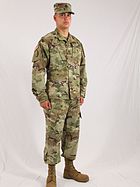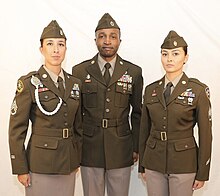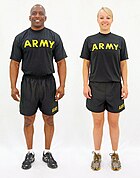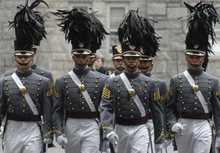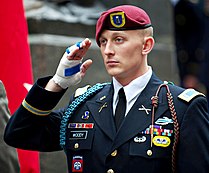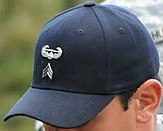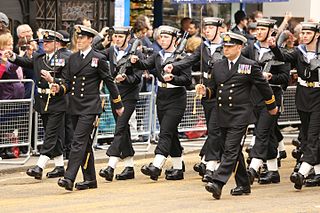History

The design of early army uniforms was influenced by both British and French traditions. One of the first Army-wide regulations, adopted in 1789, prescribed blue coats with colored facings to identify a unit's region of origin: New England units wore white facings, southern units wore blue facings, and units from Mid-Atlantic states wore red facings. [1] Bandsmen wore red uniforms to make them more easily identifiable to commanders on the field of battle. Pantaloons were originally white, following British uniforms, but were changed to gray in 1821 and sky blue in 1832. Infantry wore tricorne hats, with different cover prescribed for cavalry and specialist troops depending on function.
The original Revolutionary War enlisted uniform jacket was dark blue with state-specific facing colors. This was worn with a white waistcoat and breeches and black shoes. All ranks wore a black tricorne hat with a black cockade; later a white cockade was inset to represent the American alliance with Bourbon France. From 1782, Regulars had red facings. Foot regiments (infantry, artillery, and supporting units) wore gold-metal buttons and lace. Horse regiments (cavalry, light dragoons, and horse artillery) wore white-metal buttons and lace.
From 1810, the uniform changed to follow European trends. The tight-fitting and short-skirted double-breasted coatee replaced the single-breasted coat, and the waistcoat was discontinued. Militia wore gray coatees, still worn as a ceremonial uniform at West Point today. Regulars wore national blue (dark-blue) coatees, except for musicians, who wore reversed red coatees with blue facings. Enlisted ranks wore the coatee with a black stovepipe shako, white or gray trousers with matching button-up spats, and black short boots. [2]
Facings and buttonhole trim were discontinued in 1813. From the early days of the Continental Army, the wearing of a sword and a worsted crimson sash served as a badge of rank for all sergeant grades. By 1820, the worsted sash became a privilege of first sergeants and above only. From 1781, until 1833, the "first sergeant" was simply the senior sergeant in a company or battery and was not a separate grade of rank. [3]
Beginning in the 1850s, U.S. military leadership began to place an increased emphasis on French army tactics and styles, influenced, in part, by the rise of Napoleon III. [4] The most extreme adoption of French military fashion was in the use of zouave uniforms by some U.S. Army infantry regiments, and the purchase of 10,000 chasseurs à pied uniforms to outfit the Excelsior Brigade. [5] More subtle French styling – including frock coats, kepi hats, and collar ornaments – were more common for uniforms of the Union Army during and after the American Civil War.


Beginning in 1902, the Army made khaki and olive drab field uniforms standard issue, having seen their effectiveness in limited use during the Spanish–American War. The traditional blue was reserved for dress uniforms. Uniforms used during World War I remained substantially similar to the 1902 patterns. Blue uniforms were suspended during the conflict. During the inter-war period, piecemeal modifications were made to the designs, such as the introduction of open-collar coats, straight-legged trousers, and collared shirts with ties, resulting in uniforms that by the end of the 1930s were entirely different. A blue dress uniform was reintroduced in 1937.
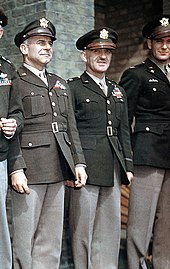
The U.S. Army uniforms used during World War II saw a divergence between field and garrison service elements. The latter necessitated by the suspension of the blue dress uniform again, leading to them becoming separate classes of uniforms by the end of the war. These uniforms continued in use into the Korean War.
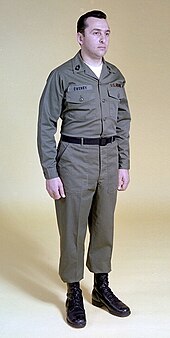
The OG-107 combat uniform was introduced as the new standard field uniform during the Korean War, and continued as the standard fatigue duty uniform for almost three decades. It saw minor changes through its lifespan.

In 1954, the Army Green Uniform, also called the "Class A" uniform, was introduced for garrison dress. [6] An alternate semi-dress uniform for the summer months, the Army Tan Uniform, continued in use until 1985, though was relegated to Class B status following the mid 1960s. The blue dress uniform, now mandatory for officers and an authorized option for enlisted soldiers, was reinstated in 1957.
The OG-107 field uniform was replaced in 1981 by the Battle Dress Uniform and Desert Battle Dress Uniform, later the Desert Camouflage Uniform, which saw use during the Gulf War. These were replaced by the Army Combat Uniform (ACU) in the mid-2000s, during the War in Afghanistan and War in Iraq. When initially introduced, the ACU used the Universal Camouflage Pattern. This proved to be an ineffective pattern and was replaced beginning in 2014 with the more effective Operational Camouflage Pattern. As of 2021 [update] , the ACU in OCP is the standard issue field uniform of the Army.
Beginning in 2010, the blue Army Service Uniform (ASU), [7] previously used as a formal dress uniform, displaced the green Class A uniform as the daily wear service uniform. This move proved unpopular, and in 2018 a new Army Green Service Uniform (AGSU) modeled after World War II-era officers garrison uniforms was announced. By October 1, 2027, all soldiers will be required to wear the AGSU as office attire. The blue uniform will remain the ceremonial and formal dress uniform. [8]
